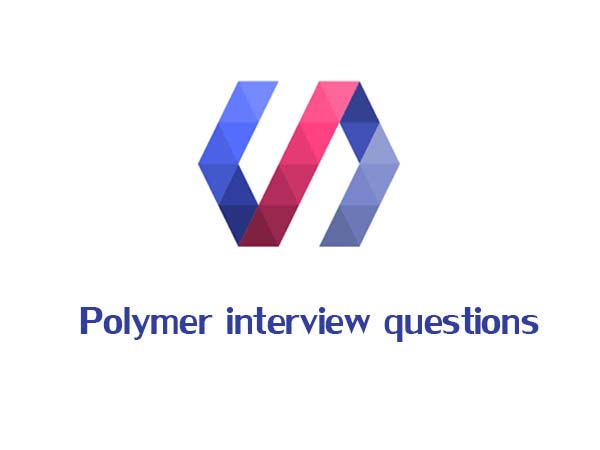Polymer is an open-source JavaScript library for building web applications using Web Components.
Polymer Interview Questions

Below are the list of Best PolymerJs Interview Questions and Answers
It is an open source JavaScript library, which is chiefly developed by Google. It is mostly used to develop web applications for using various web components like HTML. Polymer is an open-source JavaScript library for building web applications using Web Components. Google developers and contributors on GitHub are developing the library.
Polymer JS is currently the simplest way to create custom HTML elements for API development because this library is built on top of web standards API. It also has computed properties and creation of hybrid mobile applications is super easy too. Moreover, it provides gesture events, provides the polyfills by this we can create our own customized elements and distributes custom elements across network that can be used by users. Plus, it has both one way and two-way data binding. It also provides command line interface, which helps to manage the project from simple to complicated application as well as cross-browser compatible application.
The architecture of Polymer.js is divided into four important layers which are explained below:
- Native Layer: It represents the current state of browser support and implementation for the web component detail.
- Foundation Layer: It consists of polyfill libraries for the web component details. Polyfill is basically a code, which implements the feature of the web browser that does not support the feature.
- Core Layers: It comprises the Polymer library code, which is found in the polymer.html file.
- Elements Layers: This layer consists of core and paper elements.
Polymer contains a few primary collections of elements. They can be used in web pages and applications and are developed or built with the Polymer library. The polymer.js elements are as follows:
- app elements: it is used when building the entire application.
- iron elements: it is the basic building blocks for creating an application.
- paper elements: it is used to implement Google’s material design guidelines.
- gold elements: it is used to implement e-commerce-specific use cases.
- neon elements: it is used to implement animated transitions for Polymer elements.
- molecules elements: it is used to connect a group of plugins to the Polymer application.
- Google web components: it is the Google’s API and Service collection.
Custom elements provide a component model for the web. The custom element specifications offer a set of callbacks, which are known as “custom element reactions”. These allow you to run user code in response to certain lifecycle changes. Some of the reactions, which allow making changes in elements and their descriptions are listed as follows:
- Constructor: This is called when the element is upgraded (that is, when an element is created, or when a previously-created element becomes defined).
- ConnectedCallback: This is called when the element is added to a document.
- DisconnectedCallback: This is called when the element is removed from a document.
- AttributeChangedCallback: This is called when any of the element’s attributes are changed, appended, removed, or replaced.
Polymer-element.html, legacy-element.html, polymer.html are the imports used to define the Polymer elements. Import technically translates to receiving data into one program from another. The above-mentioned imports perform various functions such as define custom and hybrid polymer elements, define a base class and includes previous imports and helper elements.
DOM stands for Document Object Model. It is a property of DOM used to building components. One can think of shadow DOM as a scoped sub-tree inside the Polymer.js element. Browsers use Shadow DOM to implement default HTML components such as the <video> tag. The Shadow DOM specification allows the developers to use the same techniques in our own custom elements. DOM is basically an application-programming interface (API) for valid HTML and well-formed XML documents. It defines the logical structure of documents and the way a document is accessed and manipulated. Shadow DOM, in particular, refers to the ability of the browser to include a sub-tree of DOM elements into the rendering of a document, but not into the main document DOM tree.
Polymer observes changes on any element’s properties by taking following actions.
- Observers: It invokes the callbacks whenever any kind of data changes takes place.
- Computed Properties: It computes the virtual properties based on other properties of the elements, and then re-computes them whenever the input data changes.
- Data Bindings: It updates the properties, attributes, or the text content of a DOM node using annotations whenever the data changes take place.
It is chiefly used to connect the property and attributes of an element from the host element in its local DOM. A binding is created with a binding annotation in the host element’s local DOM template. Data binding is an important feature of Polymer.js.
The helper elements that are used for data binding cases are as follows:
- Template Repeater
- Array Selector
- Conditional Template
- Auto-binding Template
Latest Interview Questions-
Silverlight Interview Questions
-
Entity framework interview questions
-
LINQ Interview Questions
-
MVC Interview Questions
-
ADO.Net Interview Questions
-
VB.Net Interview Questions
-
Microservices Interview Questions
-
Power Bi Interview Questions
-
Core Java Interview Questions
-
Kotlin Interview Questions
-
JavaScript Interview Questions
-
Java collections Interview Questions
-
Automation Testing Interview Questions
-
Vue.js Interview Questions
-
Web Designing Interview Questions
-
PPC Interview Questions
-
Python Interview Questions
-
Objective C Interview Questions
-
Swift Interview Questions
-
Android Interview Questions
-
IOS Interview Questions
-
UI5 interview questions
-
Raspberry Pi Interview Questions
-
IoT Interview Questions
-
HTML Interview Questions
-
Tailwind CSS Interview Questions
-
Flutter Interview Questions
-
IONIC Framework Interview Questions
-
Solidity Interview Questions
-
React Js Interview Questions
Subscribe Our NewsLetter
Never Miss an Articles from us.
